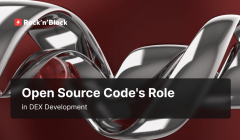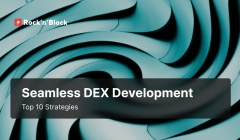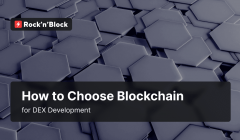Top 10 Features of DEX Development
03 May 2024In this article, we explore the fundamental elements that contribute to the success, security and inclusivity of decentralized exchange development. These include robust security measures that build trust, cutting-edge advancements in interoperability and governance, and other features that shape DEXs into sophisticated and resilient ecosystems. Explore liquidity pool management and scalability solutions with us.

Table of Contents:
Overview of DEX Development
1. Automated Market Makers (AMMs)
2. Order Books
3. Derivatives Trading (Perpetual Swaps)
4. Concentrated Liquidity
5. Wallet Integration
6. Decentralization and Governance
7. Yield Farming Development
8. Multi-Chain Trading
9. User Experience in DEX Development
10. Unique DEX Features
Conclusion
Overview of DEX Development
DEX development is based on the integration of blockchain technology and smart contracts. Unlike traditional exchanges, DEXs operate on decentralized networks, using blockchain for secure and transparent transactions. Smart contracts automate trade executions, eliminating the need for intermediaries and fostering trustless peer-to-peer exchanges.
Security is a top priority in DEX development. Multi-signature wallets and thorough smart contract auditing safeguard users' funds. Decentralization principles empower users with control over their assets and transactions, without relying on a central authority.
1. Automated Market Makers (AMMs)
Why It's Important: Automated Market Makers (AMMs) revolutionize DEX trading by providing algorithmic liquidity. AMMs use smart contracts to facilitate instant trades, with prices determined dynamically based on the ratio of assets in pools. Their flexibility and continuous liquidity make AMMs a cornerstone of vibrant and accessible DEX environments.
Effective liquidity pool management is crucial for maintaining balanced trading pairs, minimizing slippage, and enhancing overall market efficiency. Cryptocurrency decentralized exchange developers focus on optimizing algorithms and strategies to attract and retain liquidity providers, fostering a robust and competitive marketplace.
2. Order Books
Why It's Important: Order books serve as the backbone of the decentralized exchanges, providing real-time visibility into buy and sell orders. A well-designed order book system enhances market transparency, enabling users to make informed decisions based on the current supply and demand dynamics.
The order book typically consists of two sides: the buy side and the sell side. On the buy side, users place orders indicating the price and quantity they are willing to purchase, while on the sell side, users list their sell orders with corresponding prices and quantities.
DEX developers focus on optimizing order matching algorithms to efficiently pair buyers with sellers, ensuring fair and timely execution of trades. The order book is a crucial tool for traders to assess market conditions, make informed decisions, and participate in decentralized trading with confidence.
3. Derivatives Trading (Perpetual Swaps)
Why Its Important: Perpetual DEX platforms stand as a solution to the issues of both CEXs and DEXs. By addressing the gaps in trust and functionality, perpetual DEX development redefines the trading landscape.
Perpetual DEXs revolutionize trading with key features:
- Perpetual Swaps: No expiration dates, empowering flexible and pressure-free trading.
- Seamless Liquidity: Merging sources for optimal depth and minimal slippage, ensuring smooth transactions.
- Interoperability Unleashed: Built on open-source protocols, facilitating cross-platform trading, yield farming, and lending for a dynamic DeFi landscape.
- Derivatives Trading: Beyond spot trading, perpetual DEXs offer derivatives trading, enabling users to engage in advanced strategies like leverage and margin trading within the decentralized ecosystem.
4. Concentrated Liquidity
Why It's Important: Advanced liquidity management in decentralized exchange development is a critical aspect that involves implementing sophisticated strategies and mechanisms to optimize liquidity provision, enhance trading efficiency, and minimize slippage.
Uniswap v3 is pioneering a significant trend in the DEX space through its innovative approach to concentrated liquidity. Uniswap v3 introduced the concept of concentrated liquidity DEX development, enabling liquidity providers to focus their funds within specific price ranges. This innovation optimizes capital efficiency and enhances liquidity for targeted trading pairs.
5. Wallet Integration
Why It's Important: Wallet integration is pivotal in DEX development, streamlining user access directly from wallets for enhanced security, privacy, and convenience. It fosters interoperability, allowing seamless access to diverse tokens, and ensures cross-platform compatibility. WalletConnect protocol allows users to connect their wallets to the DEX directly from their devices, enhancing accessibility and convenience.
6. Decentralization and Governance
Why It's Important: Decentralization and governance are key pillars in DEX development. Decentralization makes sure that no one person or group has too much power, while governance ensures that users collectively decide on important matters, making the DEX more democratic and responsive to the community's needs.
Governance Token Implementation
Governance token implementation empowers DEX users by granting voting rights on platform changes. This democratic approach ensures community participation in decision-making, fostering a sense of ownership and active engagement.
Decentralized Autonomous Organizations (DAOs)
DAOs take community governance a step further, enabling decentralized decision-making through smart contracts. In DEX development, DAOs facilitate collective choices on protocol updates, fee structures, and listings. This model enhances the resilience and autonomy of the DEX community.
7. Yield Farming Development
Why It's Important: Yield farming plays a crucial role in decentralized exchange development by motivating users to provide liquidity to the platform. Yield farming development, also known as liquidity mining, allows users to lock up their cryptocurrencies in liquidity pools, and in return, they earn additional tokens as a reward. This process boosts the liquidity of the DEX, making it more attractive for traders.
Yield farming contributes to the overall economic model of a DEX by creating a cycle of token movement. Users stake assets, receive rewards, and may restake or trade these rewards, fostering a dynamic ecosystem.
8. Multi-Chain Trading
Why It's Important: The role of multi-chain trading in DEX development is instrumental in providing users with access to a wider array of assets, improving scalability, promoting interoperability, mitigating risks, and expanding the market reach of the DEX.
Atomic Swaps
Atomic swaps are a significant milestone in cross-chain trading, allowing assets to be swapped directly between different blockchains without the need for an intermediary. This trustless and decentralized method ensures secure asset exchange across chains.
Cross-Chain Bridge Development
The ability to facilitate communication between different blockchain ecosystems is critical to the success of cross-chain trading. Cross-chain bridge development aims to ease asset management across different blockchains. This improved communication fosters a seamless trading experience for users navigating multiple blockchains.
Layer 2 Scaling Solutions
Layer 2 scaling solutions address the scalability challenges inherent in blockchain networks. By moving certain transaction processes off the main blockchain, Layer 2 solutions reduce congestion and enhance transaction speed. DEXs are increasingly integrating Layer 2 solutions, such as sidechains and state channels, to provide users with faster and more cost-effective trading experiences.
9. User Experience in DEX Development
Why It's Important: User experience is paramount in decentralized exchange development, with a focus on creating an intuitive and accessible platform. The interface is designed for simplicity, ensuring that users, both experienced and new to crypto, can navigate and execute trades effortlessly.
Seamless onboarding is prioritized, simplifying the account creation process and providing clear guidance for users unfamiliar with decentralized finance. DEX development often integrates solutions that simplify onboarding for users, such as ERC-4337 standard. It simplifies registration, account management, and transaction fees, making it easier for web users to enter the crypto industry. This has the potential to expand the audience for project owners, benefiting the entire market.
10. Unique DEX Features
Why It's Important: By tailoring features to meet the preferences and interests of your user base, you can create a distinctive and attractive ecosystem that sets your DEX apart in the decentralized finance landscape.
Several decentralized exchanges have gained popularity by offering unique features that cater to users' diverse needs. Below are some examples of such features from real-world DEXs.
Uniswap
Uniswap pioneered automated market making (AMM) and introduced concentrated liquidity in Uniswap v3. This allows liquidity providers to focus their funds within specific price ranges, optimizing capital efficiency and reducing impermanent loss.
SushiSwap
SushiSwap introduced "Onsen", a unique yield farming program where users can stake their LP tokens to earn SUSHI rewards. This incentivizes liquidity provision and community participation.
Balancer
Balancer offers programmable liquidity through customizable liquidity pools, allowing users to create and manage liquidity portfolios with multiple tokens and different weights. This provides advanced users with a tool for portfolio management within the DEX.
Curve Finance
Curve Finance specializes in stablecoin trading, providing low-slippage and low-fee swaps for assets like USDC, DAI, and USDT. Its unique algorithm focuses on efficient stablecoin trading, making it attractive for users seeking stable asset swaps.
To enhance user engagement and attract a broader audience, consider implementing custom features within your decentralized exchange development. For instance, introducing a referral program can incentivize existing users to invite others, fostering community growth. Lotteries or reward-based contests add an element of excitement, encouraging users to actively participate and potentially win additional tokens. Additionally, creative tokenomics, such as unique staking mechanisms or exclusive membership tiers, can contribute to a dynamic and appealing user experience.
Conclusion
As the decentralized landscape continues to mature, the integration of these features serves as a roadmap for DEX developers, guiding them toward building robust and user-centric platforms. The adaptability to emerging technologies, a commitment to regulatory compliance, and a focus on community-driven governance underscore the progressive nature of DEX development.
We ❤️ Development
Follow us on social media to receive the hottest blockchain development updates
Twitter ⚡️Telegram⚡️LinkedIn⚡️Facebook⚡️Linktree







